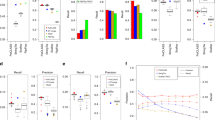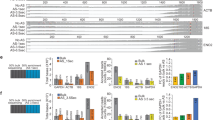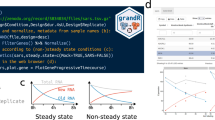Abstract
Nucleotide abundance measurements using DNA microarray technology are possible only if appropriate probes complementary to the target nucleotides can be identified. Here we present a protocol for selecting DNA probes for microarrays using the OligoWiz application. OligoWiz is a client–server application that offers a detailed graphical interface and real-time user interaction on the client side, and massive computer power and a large collection of species databases (400, summer 2007) on the server side. Probes are selected according to five weighted scores: cross-hybridization, ΔTm, folding, position and low-complexity; and probes can be placed with respect to sequence annotation using regular expressions. This protocol provides recommendations related to the design and parameter settings, and it also offers a comprehensive walkthrough of the design steps. The protocol requires limited computer skills and can be executed from any Internet-connected computer. The probe selection procedure for a standard microarray design targeting all yeast transcripts can be completed in 1 h.
This is a preview of subscription content, access via your institution
Access options
Subscribe to this journal
Receive 12 print issues and online access
$259.00 per year
only $21.58 per issue
Buy this article
- Purchase on Springer Link
- Instant access to full article PDF
Prices may be subject to local taxes which are calculated during checkout











Similar content being viewed by others
References
Hekstra, D., Taussig, A.R., Magnasco, M. & Naef, F. Absolute mRNA concentrations from sequence-specific calibration of oligonucleotide arrays. Nucleic Acids Res. 31, 1962–1968 (2003).
Zhang, L., Miles, M.F. & Aldape, K.D. A model of molecular interactions on short oligonucleotide microarrays. Nat. Biotechnol. 21, 818–821 (2003).
Wu, Z., Irizarry, R., Gentleman, R., Martinez-Murillo, F. & Spencer, F. A model-based background adjustment for oligonucleotide expression arrays. J. Am. Stat. Assoc. 99, 909 (2004).
Wu, Z. & Irizarry, R.A. Preprocessing of oligonucleotide array data. Nat. Biotechnol. 22, 656–658 (2004).
Bruun, G.M., Wernersson, R., Juncker, A.S., Willenbrock, H. & Nielsen, H.B. Improving comparability between microarray probe signals by thermodynamic intensity correction. Nucleic Acids Res. 35, e48 (2007).
Leiske, D.L., Karimpour-Fard, A., Hume, P.S., Fairbanks, B.D. & Gill, R.T. A comparison of alternative 60-mer probe designs in an in-situ synthesized oligonucleotide microarray. BMC Genomics 7, 72 (2006).
Eklund, A.C. et al. Replacing cRNA targets with cDNA reduces microarray cross-hybridization. Nat. Biotechnol. 24, 1071–1073 (2006).
SantaLucia, J. Jr. A unified view of polymer, dumbbell, and oligonucleotide DNA nearest-neighbor thermodynamics. Proc. Natl. Acad. Sci. USA 95, 1460–1465 (1998).
Mei, R. et al. Probe selection for high-density oligonucleotide arrays. Proc. Natl. Acad. Sci. USA 100, 11237–11242 (2003).
Naef, F. & Magnasco, M.O. Solving the riddle of the bright mismatches: labeling and effective binding in oligonucleotide arrays. Phys. Rev. E Stat. Nonlin. Soft Matter Phys. 68 (1 Pt 1): 011906 (2003).
Hughes, T.R. et al. Expression profiling using microarrays fabricated by an ink-jet oligonucleotide synthesizer. Nat. Biotechnol. 19, 342–347 (2001).
He, Z., Wu, L., Li, X., Fields, M.W. & Zhou, J. Empirical establishment of oligonucleotide probe design criteria. Appl. Environ. Microbiol. 71, 3753–3760 (2005).
Kane, M.D. et al. Assessment of the sensitivity and specificity of oligonucleotide (50mer) microarrays. Nucleic Acids Res. 28, 4552–4557 (2000).
Marcelino, L.A. et al. Accurately quantifying low-abundant targets amid similar sequences by revealing hidden correlations in oligonucleotide microarray data. Proc. Natl. Acad. Sci. USA 103, 13629–13634 (2006).
Shchepinov, M.S., Case-Green, S.C. & Southern, E.M. Steric factors influencing hybridisation of nucleic acids to oligonucleotide arrays. Nucleic Acids Res. 25, 1155–1161 (1997).
Vainrub, A. & Pettitt, B.M. Surface electrostatic effects in oligonucleotide microarrays: control and optimization of binding thermodynamics. Biopolymers 68, 265–270 (2003).
Duggan, D.J., Bittner, M., Chen, Y., Meltzer, P. & Trent, J.M. Expression profiling using cDNA microarrays. Nat. Genet. 21, 10–14 (1999).
Devoe, H. & Tinoco, I. Jr. The stability of helical polynucleotides: base contributions. J. Mol. Biol. 4, 500–517 (1962).
Crothers, D.M. & Zimm, B.H. Theory of the melting transition of synthetic polynucleotides: evaluation of the stacking free energy. J. Mol. Biol. 116, 1–9 (1964).
Gray, D.M. & Tinoco, I. Jr. A new approach to the study of sequence-dependent properties of polynucleotides. Biopolymers 9, 223–244 (1970).
Tinoco, I. Jr. et al. Improved estimation of secondary structure in ribonucleic acids. Nat. New Biol. 246, 40–41 (1973).
Uhlenbeck, O.C., Borer, P.N., Dengler, B. & Tinoco, I. Jr. Stability of RNA hairpin loops: A 6 -C m -U 6. J. Mol. Biol. 73, 483–496 (1973).
Borer, P.N., Dengler, B., Tinoco, I. Jr. & Uhlenbeck, O.C. Stability of ribonucleic acid double-stranded helices. J. Mol. Biol. 86, 843–853 (1974).
Chou, C.C., Chen, C.H., Lee, T.T. & Peck, K. Optimization of probe length and the number of probes per gene for optimal microarray analysis of gene expression. Nucleic Acids Res. 32, e99 (2004).
Nielsen, H.B., Wernersson, R. & Knudsen, S. Design of oligonucleotides for microarrays and perspectives for design of multi-transcriptome arrays. Nucleic Acids Res. 31, 3491–3496 (2003).
Wernersson, R. & Nielsen, H.B. OligoWiz 2.0—integrating sequence feature annotation into the design of microarray probes. Nucleic Acids Res. 33, W611–W615 (2005).
Pontius JU, W.L. Schuler GD UniGene: a unified view of the transcriptome. The NCBI Handbook. (The National Center for Biotechnology Information).
Altschul, S.F., Gish, W., Miller, W., Myers, E.W. & Lipman, D.J. Basic local alignment search tool. J. Mol. Biol. 215, 403–410 (1990).
Altschul, S.F. et al. Gapped BLAST and PSI-BLAST: a new generation of protein database search programs. Nucleic Acids Res. 25, 3389–3402 (1997).
Bonnet, G., Tyagi, S., Libchaber, A. & Kramer, F.R. Thermodynamic basis of the enhanced specificity of structured DNA probes. Proc. Natl. Acad. Sci. USA 96, 6171–6176 (1999).
Nguyen, H.K. & Southern, E.M. Minimising the secondary structure of DNA targets by incorporation of a modified deoxynucleoside: implications for nucleic acid analysis by hybridisation. Nucleic Acids Res. 28, 3904–3909 (2000).
Zuker, M. On finding all suboptimal foldings of an RNA molecule. Science 244, 48–52 (1989).
Workman, C. et al. A new non-linear normalization method for reducing variability in DNA microarray experiments. Genome Biol. 3 research0048 (2002).
Sugimoto, N. et al. Thermodynamic parameters to predict stability of RNA/DNA hybrid duplexes. Biochemistry 34, 11211–11216 (1995).
Willenbrock, H. et al. Design of a seven-genome Escherichia coli microarray for comparative genomic profiling. J. Bacteriol. 188, 7713–7721 (2006).
de Lichtenberg, U. et al. New weakly expressed cell cycle-regulated genes in yeast. Yeast 22, 1191–1201 (2005).
Mogensen, J., Nielsen, H.B., Hofmann, G. & Nielsen, J. Transcription analysis using high-density micro-arrays of Aspergillus nidulans wild-type and creA mutant during growth on glucose or ethanol. Fungal Genet. Biol. 43, 593–603 (2006).
Garrigues, C., Lauridsen, B.S. & Johansen, E. Characterisation of Bifidobacterium animalis subsp. lactis BB-12 and other probiotic bacteria using genomics, transcriptomics and proteomics (keynote address). Austr. J. Dairy Technol. 60, 84–92 (2005).
Pedersen, M.B., Iversen, S.L., Sørensen, K.I. & Johansen, E. The long and winding road from the research laboratory to industrial applications of lactic acid bacteria. FEMS Microbiol. Rev. 29, 611–624 (2005).
Benson, D.A., Karsch-Mizrachi, I., Lipman, D.J., Ostell, J. & Wheeler, D.L. GenBank. Nucleic Acids Res. 35, D21–D25 (2007).
Wernersson, R. FeatureExtract—extraction of sequence annotation made easy. Nucleic Acids Res. 33, W567–W569 (2005).
Rouillard, J.M., Herbert, C.J. & Zuker, M. OligoArray: genome-scale oligonucleotide design for microarrays. Bioinformatics 18, 486–487 (2002).
Rouillard, J.M., Zuker, M. & Gulari, E. OligoArray 2.0: design of oligonucleotide probes for DNA microarrays using a thermodynamic approach. Nucleic Acids Res 31, 3057–3062 (2003).
Mrowka, R., Schuchhardt, J. & Gille, C. Oligodb—interactive design of oligo DNA for transcription profiling of human genes. Bioinformatics 18, 1686–1687 (2002).
Wang, X. & Seed, B. Selection of oligonucleotide probes for protein coding sequences. Bioinformatics 19, 796–802 (2003).
Bozdech, Z. et al. Expression profiling of the schizont and trophozoite stages of Plasmodium falciparum with a long-oligonucleotide microarray. Genome Biol 4, R9 (2003).
Chen, H. & Sharp, B.M. Oliz, a suite of Perl scripts that assist in the design of microarrays using 50mer oligonucleotides from the 3′ untranslated region. BMC Bioinformatics 3, 27 (2002).
Reymond, N. et al. ROSO: optimizing oligonucleotide probes for microarrays. Bioinformatics 20, 271–273 (2004).
Chou, H.H., Hsia, A.P., Mooney, D.L. & Schnable, P.S. Picky: oligo microarray design for large genomes. Bioinformatics 20, 2893–2902 (2004).
Nordberg, E.K. YODA: selecting signature oligonucleotides. Bioinformatics 21, 1365–1370 (2005).
Li, C. & Wong, W.H. Model-based analysis of oligonucleotide arrays: expression index computation and outlier detection. Proc. Natl. Acad. Sci. USA 98, 31–36 (2001).
Author information
Authors and Affiliations
Corresponding author
Rights and permissions
About this article
Cite this article
Wernersson, R., Juncker, A. & Nielsen, H. Probe selection for DNA microarrays using OligoWiz. Nat Protoc 2, 2677–2691 (2007). https://doi.org/10.1038/nprot.2007.370
Published:
Issue Date:
DOI: https://doi.org/10.1038/nprot.2007.370
This article is cited by
-
Target-enrichment sequencing for detailed characterization of small RNAs
Nature Protocols (2018)
-
Adaptation of Lactococcus lactis to high growth temperature leads to a dramatic increase in acidification rate
Scientific Reports (2015)
-
Direct genotyping of C3435T single nucleotide polymorphism in unamplified human MDR1 gene using a surface plasmon resonance imaging DNA sensor
Analytical and Bioanalytical Chemistry (2015)
-
Surface plasmon resonance imaging for nucleic acid detection
Analytical and Bioanalytical Chemistry (2013)
-
Combining bulk segregation analysis and microarrays for mapping of the pH trait in melon
Theoretical and Applied Genetics (2013)
Comments
By submitting a comment you agree to abide by our Terms and Community Guidelines. If you find something abusive or that does not comply with our terms or guidelines please flag it as inappropriate.



